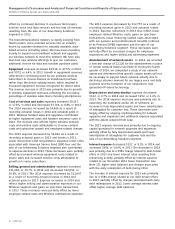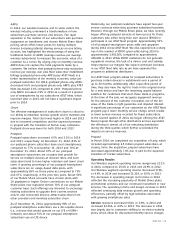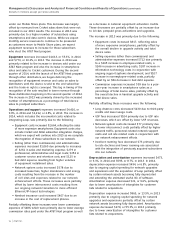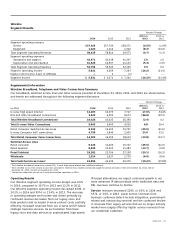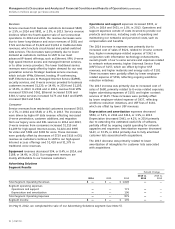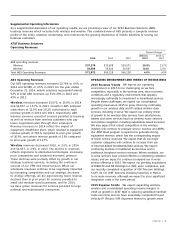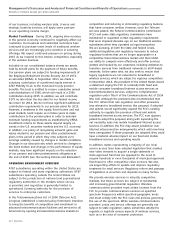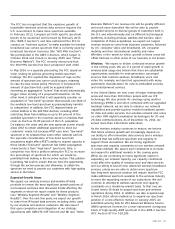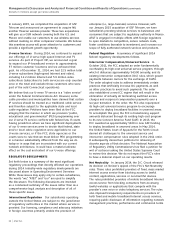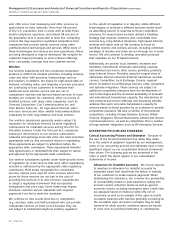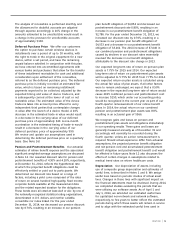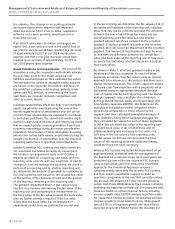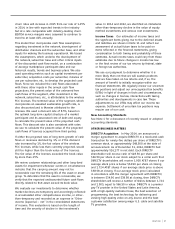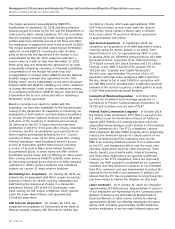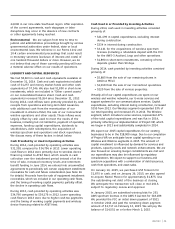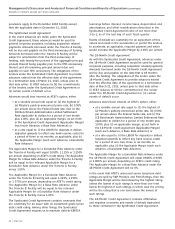AT&T Wireless 2014 Annual Report Download - page 24
Download and view the complete annual report
Please find page 24 of the 2014 AT&T Wireless annual report below. You can navigate through the pages in the report by either clicking on the pages listed below, or by using the keyword search tool below to find specific information within the annual report.
Management’s Discussion and Analysis of Financial Condition and Results of Operations (continued)
Dollars in millions except per share amounts
22
|
AT&T INC.
enterprise (i.e., large-business) services. However, with
our January 2015 acquisition of GSF Telecom, we have
subsidiaries providing wireless services to businesses and
consumers that are subject to regulatory authority in Mexico.
AT&T is engaged in multiple efforts with foreign regulators
to open markets to competition, reduce network costs,
foster conditions favorable to investment, and increase our
scope of fully authorized network services and products.
Federal Regulation A summary of significant 2014
federal regulatory developments follows.
Intercarrier Compensation/Universal Service In
October 2011, the FCC adopted an order fundamentally
overhauling its high-cost universal service program, through
which it disburses approximately $4,500 annually, and its
existing intercarrier compensation (ICC) rules, which govern
payments between carriers for the exchange of traffic.
The order adopted rules to address immediately certain
practices that artificially increase ICC payments, as well
as other practices to avoid such payments. The order
also established a new ICC regime that will result in the
elimination of virtually all terminating switched access
charges and reciprocal compensation payments over a
six-year transition. In the order, the FCC also repurposed
its high-cost universal service program to encourage
providers to deploy broadband facilities in unserved areas.
To accomplish this goal, the FCC is transitioning support
amounts disbursed through its existing high-cost program
to its new Connect America Fund (CAF). In 2013, the
FCC awarded us approximately $100 in new CAF funding
to deploy broadband in unserved areas. In May 2014,
the United States Court of Appeals for the Tenth Circuit
denied all challenges to the universal service and
intercarrier compensation rules adopted in the 2011 order.
It subsequently denied two petitions for rehearing of
discrete aspects of that decision. The National Association
of Regulatory Utility Commissioners has filed a petition for
writ of certiorari asking the United States Supreme Court
to review this decision. We do not expect the FCC’s rules
to have a material impact on our operating results.
Net Neutrality In January 2014, the D.C. Circuit released
its decision on Verizon’s appeal of the FCC’s Net Neutrality
rules. Those rules prohibited providers of fixed, mass market
Internet access service from blocking access to lawful
content, applications, services or non-harmful devices.
The rules prohibited providers of mobile broadband Internet
access service from blocking consumers from accessing
lawful websites or applications that compete with the
provider’s own voice or video telephony services. The rules
also imposed transparency requirements on providers of
both fixed and mobile broadband Internet access services,
requiring public disclosure of information regarding network
management practices, performance and commercial terms
In January 2015, we completed the acquisition of GSF
Telecom and announced an agreement to acquire NII,
another Mexican wireless provider. These two acquisitions
will give us a GSM network covering both the U.S. and
Mexico and enable our customers to use wireless services
without roaming on other companies’ networks. We believe
this seamless access will prove attractive to customers and
provide a significant growth opportunity.
U-verse Services During 2014, we continued to expand
our offerings of U-verse high speed Internet and TV
services. As part of Project VIP, we announced a goal
to expand our IP-broadband service to approximately
57 million customer locations and we achieved that
goal. As of December 31, 2014, we had 12.5 million total
U-verse subscribers (high-speed Internet and video),
including 12.2 million Internet and 5.9 million video
subscribers (subscribers to both services are only counted
once in the total and exclude those customers who were
part of the sold Connecticut operations).
We believe that our U-verse TV service is a “video service”
under the Federal Communications Act. However, some
cable providers and municipalities have claimed that certain
IP services should be treated as a traditional cable service
and therefore subject to the applicable state and local
cable regulation. Petitions have been filed at the FCC
alleging that the manner in which we provision “public,
educational and governmental” (PEG) programming over
our U-verse TV service conflicts with federal law. If courts
having jurisdiction where we have significant deployments
of our U-verse services were to decide that federal, state
and/or local cable regulation were applicable to our
U-verse services, or if the FCC, state agencies or the
courts were to rule that we must deliver PEG programming
in a manner substantially different from the way we do
today or in ways that are inconsistent with our current
network architecture, it could have a material adverse
effect on the cost and extent of our U-verse offerings.
REGULATORY DEVELOPMENTS
Set forth below is a summary of the most significant
regulatory proceedings that directly affected our operations
during 2014. Industry-wide regulatory developments are
discussed above in Operating Environment Overview.
While these issues may apply only to certain subsidiaries,
the words “we,” “AT&T” and “our” are used to simplify
the discussion. The following discussions are intended
as a condensed summary of the issues rather than as a
comprehensive legal analysis and description of all of
these specific issues.
International Regulation Our subsidiaries operating
outside the United States are subject to the jurisdiction
of regulatory authorities in the market where service is
provided. Our licensing, compliance and advocacy initiatives
in foreign countries primarily enable the provision of


